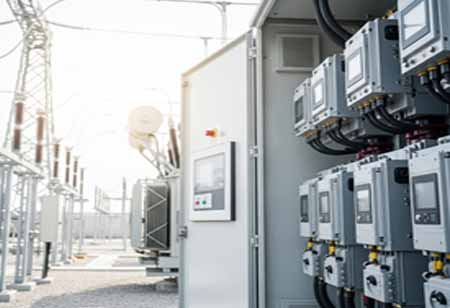Thank you for Subscribing to Electrical Business Review Weekly Brief
I agree We use cookies on this website to enhance your user experience. By clicking any link on this page you are giving your consent for us to set cookies. More info
Adapting to Change: Medium-Voltage Switchgear in the Era of Renewable Energy

By
Electrical Business Review | Tuesday, June 03, 2025
Stay ahead of the industry with exclusive feature stories on the top companies, expert insights and the latest news delivered straight to your inbox. Subscribe today.
The medium-voltage switchgear sector is experiencing a significant growth phase, driven by an increasing demand for reliable and efficient power distribution solutions. As industries evolve, particularly within the energy, manufacturing, and infrastructure sectors, there is a heightened need for enhanced power management systems. Organizations actively seek products to ensure safe, reliable, and energy-efficient operations across power grids and substations. Despite the trend toward more sophisticated power distribution mechanisms, medium-voltage switchgear is integral to effective electricity management.
This growing demand is further supported by a global movement towards energy optimization, which aims to minimize energy losses while ensuring the stability of systems. For instance, utility companies focus on rehabilitating aging infrastructure to accommodate renewable energy sources such as solar and wind, necessitating specialized equipment to address their intermittent nature.
Moreover, various regions are undertaking initiatives to modernize their energy systems to meet the increasing demand from industrial, commercial, and residential consumers. Consequently, the required medium-voltage switchgear solutions must offer flexibility, reliability, and advanced control mechanisms, thereby emerging as a primary growth driver within this sector.
Technological Advancements and Innovations in Switchgear Design
Technological advancements serve as the foundation for the medium-voltage switchgear market as manufacturers endeavor to create innovative products that align with the evolving requirements of energy distribution systems. A pivotal development in this sector is the integration of digitalization and automation, which have significantly enhanced the operational efficiency of medium-voltage switchgear. The introduction of smart grids facilitates real-time monitoring and remote control of switchgear, thereby reducing response times to faults and ultimately improving overall system performance.
The industry is increasingly oriented toward the design of environmentally sustainable and compact solutions, with a particular emphasis on gas-insulated switchgear (GIS). GIS offers several advantages, including reduced spatial requirements, enhanced durability, and diminished maintenance needs. This innovation improves operational efficiency and safety and mitigates the environmental impact associated with power distribution networks, particularly in urban settings where space is limited.
Companies are investing substantially in developing products with lower environmental footprints in response to growing sustainability concerns. These efforts encompass reducing harmful gas emissions during the operation of switchgear components and selecting recyclable and energy-efficient materials. Additionally, advancements in material science, particularly in high-performance insulation materials, contribute to the increased efficiency and reliability of medium-voltage switchgear while reinforcing a commitment to minimizing the overall environmental impact.
Challenges, Regulatory Landscape, and Future Prospects
The medium-voltage switchgear industry is experiencing significant growth but is confronted with several challenges that may impact its future trajectory. One of the most pressing obstacles is the variability of the regulatory environment across different regions, which often necessitates that manufacturers adhere to complex and evolving standards. In numerous countries, environmental regulations regarding the use of gases such as SF6, commonly utilized in switchgear, are increasingly stringent, given the gas's potent greenhouse gas effects. Consequently, manufacturers are under substantial pressure to identify alternatives to maintain operational performance while aligning with sustainable practices.
The industry is also facing considerable logistics and supply chain challenges, as many of the raw materials required for switchgear production are subject to price volatility and uncertain availability. Manufacturers must effectively address these challenges while ensuring their products remain high-quality and affordable. The growing complexity of technology requires substantial expertise and investment in research and development to incorporate digital innovations into switchgear systems. Companies must remain at the forefront of technological advancements or risk becoming obsolete as the market evolves.
Despite these challenges, the outlook for the medium-voltage switchgear industry remains favorable. The persistent demand for efficient power distribution solutions will drive manufacturers to innovate and develop new products that meet global energy requirements. The transition to renewable energy and the adoption of smart grid technologies will further underscore the significance of medium-voltage switchgear in ensuring reliable and sustainable power distribution networks.
Consolidation trends will likely gain traction as leading industry players enhance their portfolios through strategic mergers and acquisitions, enabling them to deliver comprehensive, integrated solutions. The growing consumer demand for superior quality, energy-efficient, and competitively priced products will continue to propel the industry toward heightened innovation in design and functionality. Moreover, the ongoing shift toward digitalization and automation will facilitate the emergence of new business models and service offerings, significantly contributing to the sector's future growth.
The medium-voltage switchgear industry is poised to evolve into a more energy-efficient sector, which lawmakers should consider when considering green technology policies. As energy infrastructures undergo modernization to meet new demands, the industry will remain essential in delivering reliable and efficient solutions that support a sustainable and secure energy future for all stakeholders.








